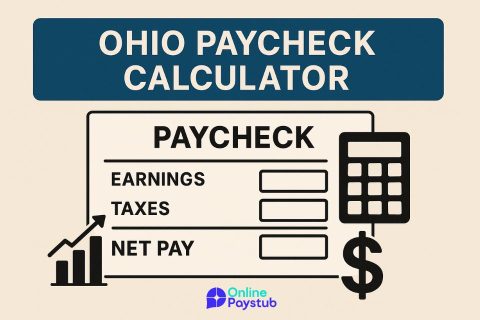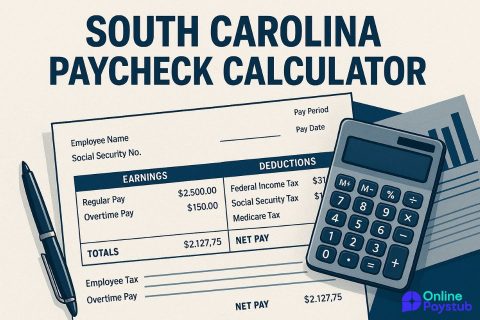Your paycheck in Washington is not as straightforward as it may seem. While the absence of a state income tax simplifies one part of the equation, several other components significantly influence what actually lands in your bank account.
At the core of your paycheck are gross pay and net pay. Gross pay is the total amount you earn before any deductions whether you’re salaried or paid hourly. Net pay, or take-home pay, is what remains after all mandatory and voluntary deductions are applied.
The primary federal deductions you will encounter include:
- Federal Income Tax Withholding: Based on your earnings, marital status, and W-4 elections, this is calculated using IRS tax tables.
- FICA Taxes: These cover Social Security and Medicare. As an employee, you pay 6.2% for Social Security and 1.45% for Medicare. Your employer matches these amounts.
- Additional Medicare Tax: If your income surpasses $200,000, you will be subject to an extra 0.9%, which is not matched by the employer.
Beyond these, your paycheck may be shaped by pre-tax contributions (such as 401(k), HSA, or FSA) and post-tax deductions (like Roth retirement accounts or voluntary insurance premiums). Each deduction reduces your taxable income differently and ultimately alters your take-home pay.
In Washington, you must also account for the Paid Family & Medical Leave (PFML) and Long-Term Care Insurance (WA Cares) deductions, both of which are state-level programs despite the absence of an income tax.
No State Income Tax: What It Means for Your Paycheck
One of the most notable aspects of earning income in Washington is the complete absence of a state income tax. This sets Washington apart from the majority of states and has a direct, positive impact on take-home pay.
In states with income tax, a portion of each paycheck is withheld to meet state tax obligations. In Washington, this step simply doesn’t exist. As a result, a larger portion of gross earnings remains in your paycheck. This can provide more financial flexibility and allow for greater savings or discretionary spending compared to residents of states with higher tax burdens, such as California or New York.
However, this does not mean Washington workers are exempt from all payroll-related deductions. Federal income tax and FICA contributions still apply. Moreover, Washington funds certain public services through other means, such as higher-than-average sales taxes and payroll-based contributions like Paid Family & Medical Leave and Long-Term Care Insurance.
For individuals relocating from a state with income tax, this shift can feel significant. For example, someone earning $70,000 annually may see a noticeably higher net income simply due to the lack of state tax withholding. Yet it’s important to remember that other living costs in Washington, such as housing or healthcare, may offset some of that gain.
Breaking Down Federal Deductions: FICA, Medicare, and More
Even without a state income tax, federal deductions have a substantial impact on every Washington paycheck. These deductions are mandated and apply regardless of income level or employment type. The key components to understand here are Federal Income Tax, FICA, and Additional Medicare Tax.
Federal Income Tax Withholding is calculated based on several inputs: your filing status (single, married, head of household), the number of dependents you report, and any extra amounts you choose to withhold. This information is collected through the IRS Form W-4. The withholding amount increases as your income rises, and is structured through progressive tax brackets.
FICA, which stands for the Federal Insurance Contributions Act, includes two separate taxes:
- Social Security Tax: 6.2% of your gross wages, up to the annual wage cap ($168,600 in 2025).
- Medicare Tax: 1.45% of all gross wages, with no income cap.
Employers are required to match both of these taxes, meaning the total contribution is 12.4% for Social Security and 2.9% for Medicare.
For high-income earners, there’s also an Additional Medicare Tax of 0.9% applied to wages exceeding $200,000 for single filers or $250,000 for married couples filing jointly. This tax is only paid by the employee and is not matched by the employer.
It’s also important to note that self-employed individuals are responsible for the full 15.3% combined FICA rate, as there is no employer to share the burden. However, they can deduct the employer-equivalent portion when filing annual taxes, slightly reducing the net cost.
How Pre-Tax and Post-Tax Deductions Shape Your Take-Home Pay
Not all deductions are created equal. Some reduce your taxable income before federal taxes are applied, while others come out of your paycheck after taxes have been calculated. Understanding this distinction is critical for accurately projecting your net income in Washington.
Pre-tax deductions are withheld before income and payroll taxes are applied. These deductions effectively lower your gross taxable income, resulting in less tax liability. Common examples include:
- 401(k) contributions
- Health Savings Accounts (HSA)
- Flexible Spending Accounts (FSA)
- Employer-sponsored health, dental, and vision premiums
- Commuter benefits
Contributing to these accounts allows you to defer taxes on a portion of your income, which can significantly increase your long-term savings or reduce immediate tax burdens.
In contrast, post-tax deductions are withheld after taxes have already been calculated and deducted. These do not reduce your taxable income but may still represent a meaningful portion of your paycheck. Examples include:
- Roth 401(k) contributions
- Union dues
- Voluntary life insurance premiums
- Charitable donations deducted through payroll
Let’s consider a scenario: Suppose you earn $80,000 annually and contribute 6% to a traditional 401(k). That $4,800 is not taxed federally, nor is it subject to FICA, which directly increases your take-home pay compared to contributing the same amount to a Roth 401(k).
Impact of Pay Frequency: Bi-Weekly vs Monthly Paychecks
How often you’re paid has more influence on your financial planning than most people realize. While your annual salary remains constant, the pay frequency determines the size and timing of each paycheck, which in turn affects budgeting, savings habits, and even tax withholding dynamics.
In Washington, as in other states, common pay frequencies include:
- Weekly (52 pay periods)
- Bi-weekly (26 pay periods)
- Semi-monthly (24 pay periods)
- Monthly (12 pay periods)
Let’s say your annual salary is $78,000:
- On a monthly schedule, you receive $6,500 before deductions.
- On a bi-weekly schedule, it becomes roughly $3,000 every other week.
Although the total earnings are the same, how they’re split matters. Smaller, more frequent paychecks can support regular expense management and reduce the need for short-term borrowing. On the other hand, monthly pay may encourage broader budgeting discipline and can be useful for those with fixed monthly obligations like rent or mortgages.
How 401(k), HSA, and Other Benefits Affect Your Net Pay
Employee benefits like retirement plans and medical savings accounts offer powerful tax advantages, but they also impact the amount you take home each pay period. In Washington, where no state income tax is levied, the effect of these benefits is seen most clearly in federal tax liability and overall paycheck structure.
401(k) contributions, for instance, are deducted from gross pay before taxes. This reduces your taxable income, which means you pay less in federal income tax and FICA. For example, contributing 10% of an $85,000 salary to a traditional 401(k) reduces your taxable income by $8,500 annually. That can translate to several hundred dollars in tax savings, depending on your tax bracket.
Health Savings Accounts (HSA) and Flexible Spending Accounts (FSA) operate under similar tax-preferred principles. Contributions to these accounts are excluded from federal income and payroll taxes, provided they’re used for qualifying medical expenses. For individuals with high-deductible health plans, an HSA can serve both as a savings vehicle and a tax shield.
Additionally, premiums for employer-sponsored health insurance, dental, and vision plans are usually deducted pre-tax. This reduces your reported income and, by extension, your tax obligations. However, benefits like life insurance premiums above $50,000 in coverage, or short-term disability plans, may be treated as post-tax deductions depending on plan design.
In Washington, benefit elections also influence state-specific deductions like the Paid Family and Medical Leave (PFML) premium. While this deduction is mandatory, its amount is based on your total wages after certain pre-tax benefits are subtracted.
Employees should also consider the long-term effects of benefit choices. Opting for a Roth 401(k) instead of a traditional one results in post-tax contributions but offers tax-free withdrawals in retirement. While it reduces your net pay now, it can provide significant benefits later.
Using a Washington-specific paycheck calculator with inputs for each of these elements allows you to model the precise trade-offs between current net income and future tax advantages. In short, your benefit decisions shape not just your paycheck, but your financial future.




No comments to show.